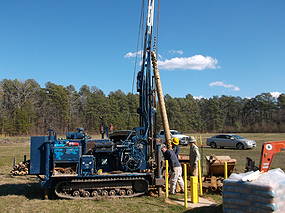Longhorn Army Ammunition Plant
Environmental Restoration Program
Remedial Technologies
Groundwater Treatment Plant
The Groundwater Treatment Plant ( GWTP) is a wastewater treatment plant, located just outside of Site LHAAP-18/24.
The GWTP treats extracted water through air stripping, precipitation, and biological methods. Treated water that is deemed below regulated contamination standards (or clean) is released to Harrison Bayou, if the Bayou has ample flowing water. If the water flow in Harrison Bayou is low, the treated water is then released onto LHAAP-18/24 via a sprinkler system, or into a holding pond, for later treatment.
Monitored Natural Attenuation
Monitored natural attenuation ( MNA) is the monitoring of groundwater to confirm whether natural attenuation (or gradual lessening of contaminants) processes are occurring, and occurring at a sufficient rate.
Monitoring is achieved by periodic groundwater sampling of monitoring wells at each site. These wells are located both inside the known contaminant plume, and outside of it. This helps to find the extent of the contamination, and determine if the plume is growing, shrinking, or moving.
ISB
In-situ bioremediation ( ISB) can sound like a very complicated procedure, but it explains itself in its name: in-situ means “in place”, so the treatment occurs without having to move soil or water; “bio” refers to the use of a living organism (bacteria); and finally, “remediation” refers to how the treatment is a remedy. ISB provides a natural way of treating contaminants as opposed to treating the contaminants of concern with chemicals.
ISB involves injecting a compound called a “substrate” (usually vegetable oil, molasses, corn syrup, or proprietary blends based upon the contaminant) into the contamination plumes. The injected material stimulates naturally occurring bacteria to thrive, and in the process breaks down contaminants. If the bacteria present at the site are not capable of breaking down the contaminant of concern, the correct bacteria can be injected into the same areas as the substrate, a process known as “ bioaugmentation”.
Soil Removal
Soil removal is the removing of contaminated soil to a designated landfill, and then backfilling the newly excavated area with clean topsoil.
This process involves sampling of the supposed contaminated area to define the extent of the area to be excavated. Once the initial excavation is complete and the contaminated soil has been removed, confirmation samples are again collected from the side walls and floor of the newly excavated area to ensure all waste has been removed. If the results come back positive for additional contaminants, these areas are further excavated and retested. This process of testing and excavation continues until the results for contaminants in the soil come back below cleanup levels. Then the excavated area is backfilled with pre-tested and varified clean topsoil.












